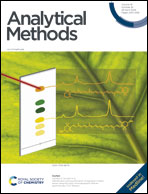The selective extraction of dietary polyamines from chicken breast using the application of a lab-on-a-chip electromembrane and dispersive liquid–liquid microextraction followed by gas chromatography-mass spectrometry
Abstract
Excessive dietary polyamines (PAs), including putrescine (PUT), spermine (SPM), and spermidine (SPD), have become a worldwide concern due to their carcinogenicity and reduced shelf life. A modern miniaturized on-chip electromembrane extraction (EME) has been applied to extract these compounds from chicken breast samples. This method is based fundamentally on ionic compounds' electrostatic attraction, diffusion, and solubility in the acceptor phase. The chemical structure of polyamines enables their efficient extraction using an electric driving force on a microchip device. HCl solution (0.1 mol L−1) was applied as an aqueous acceptor solvent. Dispersive liquid–liquid microextraction was performed after EME to facilitate joining three-phase EME to GC-MS and improve the merit figures. The total ranges of 3.77–7.89 μg g−1, 3.48–7.02 μg g−1, and 0.78–2.20 μg g−1 were acquired as PUT, SPM and SPD concentrations in chicken breast, respectively. The results demonstrate that the level of PAs in fresh chicken breast samples is not concerning, but it may reduce the quality of chicken meat over time. This novel analytical technique has several advantages: high recovery, substantial quickness, remarkable selectivity, and good enrichment factors. This emerging method could be generalized to other studies to analyze different foodstuffs.



 Please wait while we load your content...
Please wait while we load your content...